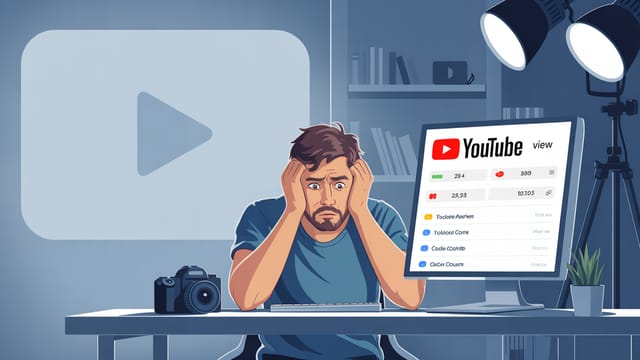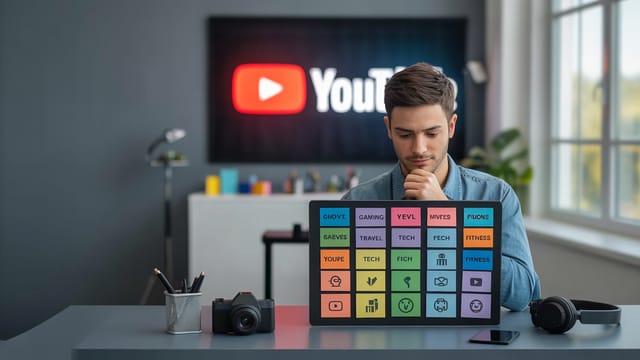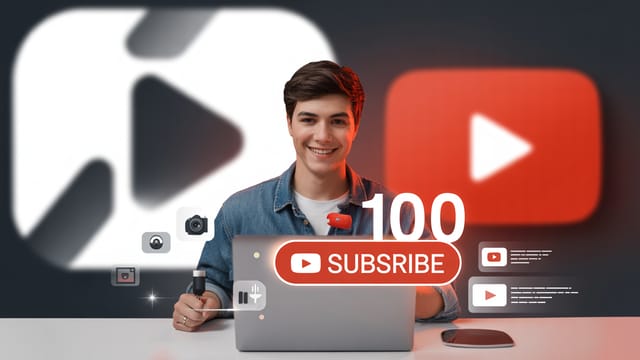
Ready to get your next 10,000 subscribers?
Join thousands of creators who use Subscribr to create faster, better YouTube videos.
Creating Searchable Content on YouTube: A Repeatable System
Getting your videos discovered on YouTube can feel like trying to find a single grain of sand on a beach. Many creators struggle with getting their content found in search and recommendations, feel uncertain about keyword strategy, and constantly battle the challenge of generating engaging video ideas that actually resonate. The good news? You don't need a magic formula. You need a repeatable system.
This article will walk you through a systematic workflow for producing YouTube content that is inherently optimized for search discovery, designed not just to tick algorithm boxes, but to genuinely serve your audience and keep them watching.
Beyond Traditional SEO: What Makes Content Searchable Today?
Forget the outdated advice about stuffing keywords into every corner of your metadata. While metadata still plays a role, YouTube's algorithm has evolved significantly. Today, "searchable" content isn't just content that matches a search query; it's content that satisfies the viewer who made that query.
The algorithm prioritizes viewer satisfaction and engagement signals. This means watch time, audience retention, likes, comments, shares, and click-through rate (CTR) from the search results page are paramount. Your goal is to create videos that not only show up in search but also compel someone to click and then keep them watching.
Think of it this way: YouTube's search function is a delivery system. Your content is the product. If your product consistently delights the customer (the viewer), the delivery system is more likely to recommend it to others searching for similar things. Creating searchable content in 2025 is about earning your discoverability by providing exceptional value.
Step 1: Understanding Your Audience and Niche (The Foundation)
Before you even think about video ideas or keywords, you need to deeply understand who you're making content for and what their needs, desires, and problems are. Your niche is the specific corner of YouTube where your audience lives, and your content should speak directly to them.
- Know Your Viewer: What questions are they asking? What solutions are they looking for? What kind of entertainment do they crave? Put yourself in their shoes.
- Define Your Niche: What specific topics do you cover? Who is your ideal viewer? The more focused you are, the easier it is to identify what your target audience is searching for.
Understanding your audience is the bedrock of creating content that resonates. Content that feels like it was made specifically for the viewer is far more likely to keep them engaged, which signals value to the YouTube algorithm. Tools like Subscribr's audience persona generation can help you visualize and understand your target demographics, interests, and content preferences based on data.
Step 2: Strategic Ideation & Validation (Finding What People Actually Search For)
This is where you bridge the gap between knowing your audience and finding video ideas they are actively searching for. It's not about guessing; it's about strategic research.
- Identify Search Demand: Look for specific, niche topics within your area of expertise that people are searching for but where there might be less competition. These lower-competition search terms can be excellent entry points for new viewers to discover your channel.
- Spot Content Gaps: Analyze successful content in your niche. What topics are covered well? What questions are left unanswered? Can you offer a fresh perspective or a more comprehensive solution? Subscribr's Competitive Analysis tools and Video Breakdown feature can help you study top-performing videos to identify successful strategies and content gaps you can fill.
- Validate Your Ideas: Don't just jump on the first idea. Consider if the idea genuinely addresses a search query or viewer need. Does it have the potential to keep viewers engaged? You can use tools like Subscribr's Research Assistant to quickly gather information and analyze existing content around potential topics, helping you validate whether an idea has searchable potential and audience interest.
One effective approach is to experiment with a few different video formats and topics within your niche initially. Make 5-10 videos on subjects you're passionate about. This helps you stay consistent long-term while also giving you initial data to work with. Pay attention to which of these early videos perform best – this is your audience telling you what they resonate with most.
Step 3: Crafting the Content for Maximum Value & Retention
Once you have a validated idea, the focus shifts to execution. The quality and structure of your video are critical for viewer retention, which directly impacts search performance.
- Deliver on the Promise: Your video must deliver exactly what your title and thumbnail promised. Don't mislead viewers; it hurts your credibility and audience retention.
- Hook Them Early: The first 15 seconds are crucial. You need a compelling hook that grabs attention and makes viewers want to watch the rest of the video. Subscribr's Hook Creation Tools can help you generate effective introductions designed to capture viewer attention immediately.
- Provide Value: Is your video entertaining, educational, or inspiring? Ensure every moment adds value. Content Creators who put themselves in their audience's shoes and create content that directly addresses their needs see higher engagement.
- Structure for Retention: Organize your content logically. Use clear transitions and maintain good pacing. Avoid unnecessary rambling. Subscribr's Script Building Pipeline takes you from research and outlining to a finished script, helping you structure your content effectively.
Remember, the goal is to make viewers feel compelled to watch your video, as if they would miss out if they didn't. High audience retention signals to YouTube that your video is valuable and should be shown to more people searching for similar topics.
Step 4: On-Video Optimization (Giving the Algorithm the Right Signals)
While not about keyword stuffing, metadata is still essential for helping YouTube and potential viewers understand what your video is about. This is about clarity and relevance.
- Titles: Your title should be clear, accurate, and compelling. Include the core topic or a relevant keyword naturally if it makes sense and helps viewers understand the video's content. Aim for titles that are both search-friendly and encourage clicks.
- Thumbnails: Your thumbnail is arguably the most important optimization element for search. It needs to be visually striking, clearly represent the video's content, and work in tandem with your title to maximize click-through rate (CTR). Analyze successful thumbnails in your niche for inspiration (Subscribr's Thumbnail Style Analysis can assist here).
- Descriptions: Write detailed, readable descriptions that provide context about your video. Include relevant keywords and phrases naturally within sentences. Think of the description as a mini-blog post summarizing your video.
- Tags: Use a variety of relevant tags, including specific terms related to your video's exact topic and broader terms related to your niche. Tags help the algorithm understand the context of your video.
- Settings & Category: Ensure you select the correct category and other relevant settings for your video. This provides the algorithm with important classification information.
- Chapters: Adding video chapters helps viewers navigate your content, improving the user experience and potentially boosting watch time.
- Captions: Providing accurate captions (either auto-generated and reviewed or manually created) improves accessibility and gives the algorithm more text to understand your video.
These on-video optimization elements are not just for the algorithm; they are crucial communication tools for your potential viewers browsing search results.
Step 5: Analyze, Iterate, and Refine (The Repeatable Cycle)
The final step in the repeatable system is analysis and continuous improvement. You can't optimize what you don't measure.
- Use YouTube Analytics: Dive into your data. Which videos are getting found in search? Which have high watch time and retention? Which generate comments and likes? Pay close attention to views, watch time, and comments on your initial experimental videos to see what resonates most.
- Identify What Works: Analyze your best-performing videos. What topics, formats, hooks, or optimization strategies did they use? Subscribr's Channel Intelligence system and Video Intel features provide detailed performance metrics and analysis tools to help you understand what's working on your channel and in your niche. Look at the Outlier Score to identify videos that significantly outperformed your channel's average.
- Double Down and Iterate: Once you identify what resonates, make more videos that the person who watched your best-performing video would love to watch next. Don't just repeat yourself; find ways to evolve and improve based on your learnings.
- Continuously Learn: The YouTube landscape is always changing. Stay curious, watch other creators, and continuously refine your system based on new insights and your channel's performance data. If something stops working, analyze why and try a different approach.
This cycle of creating, optimizing, analyzing, and iterating is the core of building a channel that consistently creates searchable content.
Building the System with Subscribr
Implementing this repeatable system for creating searchable content is made significantly easier with a platform designed specifically for YouTube creators. Subscribr provides a suite of integrated tools to support every step of this process:
- Understanding Your Audience: Use Audience Personas and Channel Intelligence to gain deep insights into who your viewers are and what content they engage with.
- Strategic Ideation & Validation: Leverage the Research Assistant, Competitive Analysis, and Video Breakdown tools to identify search opportunities, spot content gaps, and validate your ideas based on real data.
- Crafting High-Value Content: Utilize the Script Building Pipeline, Hook Creation Tools, and Script Analytics to plan, write, and refine engaging scripts that maximize viewer retention.
- On-Video Optimization: Get support for creating compelling titles, descriptions, and thumbnail briefs.
- Analyzing & Iterating: Use Channel Intelligence, Video Intel, and the Outlier Score to analyze your performance, identify what's working, and inform your future content strategy.
By providing a structured workflow and powerful data analysis capabilities, Subscribr helps creators move from uncertainty and guesswork to a confident, repeatable system for creating content that gets found, watched, and loved by their target audience. This systematic approach not only boosts your search rankings but also builds a loyal viewership, leading to more consistent views and monetization opportunities.
Conclusion
Creating searchable content on YouTube in 2025 is less about gaming the algorithm and more about genuinely serving your audience. By implementing a repeatable system that focuses on deep audience understanding, strategic ideation, high-value content creation, smart optimization, and continuous analysis, you can consistently produce videos that not only appear in search results but also keep viewers engaged and coming back for more.
Stop struggling with unpredictable discovery and start building a reliable system. Focus on providing exceptional viewer value, analyze what resonates, and use your insights to fuel your next creation. This systematic approach is the key to unlocking consistent views from YouTube search and building a thriving channel.





